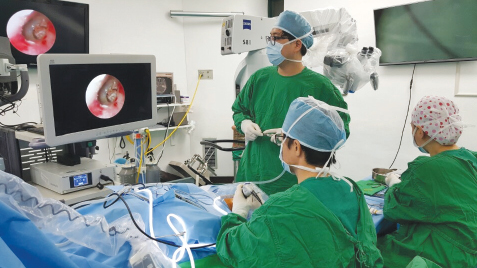Hanyang Med Rev.
2017 May;37(1):25-29. 10.7599/hmr.2017.37.1.25.
Cutting Edge Technologies in Otology Field
- Affiliations
-
- 1Department of Otolaryngology-Head and Neck Surgery, Hanyang University Guri Hospital, Korea. shleemd@hanyang.ac.kr
- KMID: 2384004
- DOI: http://doi.org/10.7599/hmr.2017.37.1.25
Abstract
- The development of science and technology leads to the development of medicine. With the development of information technologies, artificial intelligence and wearable devices, the future medical environment will change greatly. Various sciences and technology are applied in medical practice. The development of optical technology has enabled less invasive ear surgery with an endoscope, and virtual reality technology can be used for surgical training and education. Otology research tries to adapt artificial intelligence, which have rapidly developed a remarkable topic. Herein, cutting edge technologies and their appliance in the otology field were reviewed.
Keyword
Figure
Cited by 1 articles
-
Current update in diverse diseases
Seong-Ho Koh
Hanyang Med Rev. 2017;37(1):1-1. doi: 10.7599/hmr.2017.37.1.1.
Reference
-
1. Preyer S. Endoscopic ear surgery - a complement to microscopic ear surgery. HNO. 2016; 64:782–789.2. Kozin ED, Gulati S, Kaplan AB, Lehmann AE, Remenschneider AK, Landegger LD, et al. Systematic review of outcomes following observational and operative endoscopic middle ear surgery. Laryngoscope. 2015; 125:1205–1214.
Article3. Piromchai P, Avery A, Laopaiboon M, Kennedy G, O'Leary S. Virtual reality training for improving the skills needed for performing surgery of the ear, nose or throat. Cochrane Database Syst Rev. 2015; Cd010198.
Article4. Lopez EA, Costa OA, Ferrari DV. Development and Technical Validation of the Mobile Based Assistive Listening System: A Smartphone-Based Remote Microphone. Am J Audiol. 2016; 25:288–294.
Article5. Bottrill I, Perrault DF Jr, Poe D. In vitro and in vivo determination of the thermal effect of middle ear endoscopy. Laryngoscope. 1996; 106:213–216.
Article6. Kozin ED, Lehmann A, Carter M, Hight E, Cohen M, Nakajima HH, et al. Thermal effects of endoscopy in a human temporal bone model: implications for endoscopic ear surgery. Laryngoscope. 2014; 124:E332–E339.
Article7. Badr-el-Dine M. Value of ear endoscopy in cholesteatoma surgery. Otol Neurotol. 2002; 23:631–635.
Article8. Choi N, Noh Y, Park W, Lee JJ, Yook S, Choi JE. Comparison of Endoscopic Tympanoplasty to Microscopic Tympanoplasty. Clin Exp Otorhinolaryngol. 2016.
Article9. Marchioni D, Soloperto D, Villari D, Tatti MF, Colleselli E, Genovese E, et al. Stapes malformations: the contribute of the endoscopy for diagnosis and surgery. Eur Arch Otorhinolaryngol. 2016; 273:1723–1729.
Article10. Kempfle J, Kozin ED, Remenschneider AK, Eckhard A, Edge A, Lee DJ. Endoscopic Transcanal Retrocochlear Approach to the Internal Auditory Canal with Cochlear Preservation: Pilot Cadaveric Study. Otolaryngol Head Neck Surg. 2016; 154:920–923.
Article11. Kiringoda R, Kozin ED, Lee DJ. Outcomes in Endoscopic Ear Surgery. Otolaryngol Clin North Am. 2016; 49:1271–1290.
Article12. Nash R, Sykes R, Majithia A, Arora A, Singh A, Khemani S. Objective assessment of learning curves for the Voxel-Man TempoSurg temporal bone surgery computer simulator. J Laryngol Otol. 2012; 126:663–669.
Article13. George AP, De R. Review of temporal bone dissection teaching: how it was, is and will be. J Laryngol Otol. 2010; 124:119–125.
Article14. Wiet GJ, Stredney D, Kerwin T, Hittle B, Fernandez SA, Abdel-Rasoul M, et al. Virtual temporal bone dissection system: OSU virtual temporal bone system: development and testing. Laryngoscope. 2012; 122:Suppl 1. S1–S12.15. Patel VL, Shortliffe EH, Stefanelli M, Szolovits P, Berthold MR, Bellazzi R, et al. The coming of age of artificial intelligence in medicine. Artif Intell Med. 2009; 46:5–17.
Article16. Coiera E. Guide to Health Informatics. UK: CRC Press;2015.17. Joutsijoki H, Varpa K, Iltanen K, Juhola M. Machine learning approach to an otoneurological classification problem. Conf Proc IEEE Eng Med Biol Soc. 2013; 2013:1294–1297.
Article18. Priesol AJ, Cao M, Brodley CE, Lewis RF. Clinical vestibular testing assessed with machine-learning algorithms. JAMA Otolaryngol Head Neck Surg. 2015; 141:364–372.
Article19. Laurikkala JP, Kentala EL, Juhola M, Pyvkko IV. A novel machine learning program applied to discover otological diagnoses. Scand Audiol Suppl. 2001; 100–102.
Article20. Yeh SC, Huang MC, Wang PC, Fang TY, Su MC, Tsai PY, et al. Machine learning-based assessment tool for imbalance and vestibular dysfunction with virtual reality rehabilitation system. Comput Methods Programs Biomed. 2014; 116:311–318.
Article21. Vanneste S, Ridder DD, Song JJ. Toward an Objectification of Tinnitus Machine Learning Approach of Resting-State Cortical Oscillation Pattern can Detect the Presence of Tinnitus. In : International Congress of Korean Society of Otorhinolaryngology-Head&Neck Surgery 2015;22. Aldaz G, Puria S, Leifer LJ. Smartphone-Based System for Learning and Inferring Hearing Aid Settings. J Am Acad Audiol. 2016; 27:732–749.
Article23. Kim MB, Chung WH, Choi J, Hong SH, Cho YS, Park G, et al. Effect of a Bluetooth-implemented hearing aid on speech recognition performance: subjective and objective measurement. Ann Otol Rhinol Laryngol. 2014; 123:395–401.
Article





